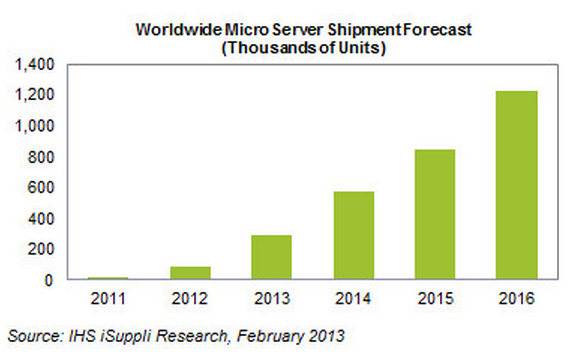IHS Predicts Microservers Are On the Rise
IHS iSuppli believes that shipments of so-called microservers—equipped with low-power processors and designed for datacenter use—will climb a whopping 230 percent this year. While that’s an enviable percentage increase for any industry. The number of actual microservers shipped will likely remain small: 291,000 units in total, versus 88,000 units in 2012. IHS believes that’s just the beginning, with microservers making up a full 10 percent of all servers sold by 2016. IHS iSuppli defines a microserver as a server housing single or multiple low-power microprocessors, consuming less than 45 watts in a single motherboard, and sharing power, cooling and cabling resources. According to estimates by market research firm Gartner, powering and cooling a single average x86 server costs $400 a year (hat-tip to Inc for that bit of data). Migrating to microservers can cut the cost by a third to a half, an attractive target for the numerous vendors announcing plans to tap into this emerging market. “Micro servers provide a solution to the challenge of increasing data-center usage driven by mobile platforms,” Peter Lin, senior analyst for compute platforms at IHS, wrote in a statement. “With cloud computing and data centers in high demand in order to serve more smartphones, tablets and mobile PCs online, specific aspects of server design are becoming increasingly important, including maintenance, expandability, energy efficiency and low cost.” Those factors, he added, give microservers an advantage over higher-end machines such as mainframes and enterprise serves, “all of which emphasize performance and reliability instead.” But other research firms feel it could be some time before microservers become a sizable presence in the market. Gartner has predicted that, by 2015, just 2.4 percent of the total server market will be owned by what the firm terms “extreme low energy servers”, or ELEs—what IHS dubs microservers. By comparison, IDC puts the total number of servers sold for the third quarter of 2012 at 2.46 million units—yet another researcher suggesting that microservers are some distance away from putting a meaningful dent in the server market, as IHS predicts. So far, it’s probably fair to say that interest in low-power servers—of any stripe—outstrips customer willingness to open their wallets, likely because customers have built the power consumption of a Xeon or Opteron system into their operating budgets. But as more CIOs ask tough questions about minimizing infrastructure spend, more and more companies may consider a lower-power alternative. Image: IHS


